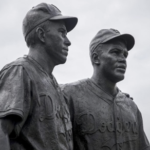
Over the last 20-plus years, I have saved copies of various articles highlighting the critical Human Resources agenda for the coming year. One of the issues that have enjoyed a top ten billing, one way or the other, is diversity and inclusion. During the 1990s, high-profile lawsuits rocked the financial industry, and DE&I was at the centre of the Human Resources radar. That was 30 years ago.
The reality is that today, in 2022, diversity and inclusion remain a challenge. My frustration and concern are why does DE&I remain more of an issue today than ever before? After all, inclusive companies are more profitable and sustainable.
Jonathan Swift, the 18th-century Anglo-Irish satirist, captured today’s dilemma perfectly: “Reasoning will never make a man correct an ill opinion, which by reasoning he never acquired.”
The issue is so deeply ingrained that talking about it and mandating training programs has not improved things; perhaps it has made things worse. It is not a new problem; it is the one that haunts people going back to probably when people could make a judgement about one another. The issue is not new to me. On a personal note, my father, a sergeant in the US Army during WWII, wrote a letter in 1940 to Yank (the US Army newspaper) hoping, as an outcome of the war, “Jim Crow laws” would end. He was not praised for being lightyears ahead of his time. On two different occasions, efforts were made by other American soldiers, to kill him.
Why do people feel that a training course is a pathway to transforming the unconscious into the conscious? While well-intended, if the programs on unconscious bias were successful, the issue would no longer be of central concern.
The evidence about the success of the DEI training program is to the contrary. The Harvard Business Review article: “Why Diversity Programs Fail” by Frank Dobbin and Alexandra Kale (July–August 2016) documented the lack of movement resulting from formal training programs.
It is true that DEI training fosters moments of cooperation but not sustained behaviour and attitude changes. We know that corporate diversity training alone does not work. It often backfires. The measure of success of the diversity programs would be:
- Reducing expressions of bias,
- Eliminating discrimination,
- Foster greater collaboration across groups,
- Help with retaining employees from historically marginalized or underrepresented groups,
- Increase productivity, and
- Reduce conflicts in the workplace.
If we accomplish these outcomes, there will be sustained behaviour change.
One source of failure is that training has led some people to embrace stereotypes they previously did not hold. By identifying the perceptions that cause prejudice, I have heard some participants wonder if the stereotype is justified. Another unintended outcome, some employees are critical of the company’s awareness of and attentiveness to the importance of racial and social justice. In today’s politically charged environment, employees are likely to react negatively. One sign of the impact is that some employees feel the focus on DEI is an attack on their perspective of right and wrong. Consequently, many of these employees have dug deeper into their resistance to any efforts to focus on DEI.
What Is a Company to Do?
 If you follow my father’s wisdom, nothing will change until people respect and trust one another based on personal experience. To achieve this, is to build a society that accepts one another as equals, working and living together in harmony.
If you follow my father’s wisdom, nothing will change until people respect and trust one another based on personal experience. To achieve this, is to build a society that accepts one another as equals, working and living together in harmony.
Is achieving a caring and accepting community possible? Several years ago, this was what a client did to right a wrong and achieved such a work environment. The company headquarters is in the heartland of the Midwest US. Historically, in the late 1800s, the founder was a racist. When a person of colour was hired, they would never be promoted to a position of responsibility. The practice persisted for decades. In the mid-1980s, things changed.
In the mid-1980s, the grandchildren’s generation announced a heartfelt apology to the employees for past behaviour and policies. It was not through a memo or town hall meeting. The message was delivered by the CEO in person, in small groups. There was no script, only a personal and emotional expression of regret for his grandfather’s and father’s actions. There were no unconscious bias programs or the development of lists of stereotypes.
The meeting was also co-facilitated by the only person of colour who had risen to supervisor. He shared his emotional stories of how he felt and provided examples of coworkers’ actions against him. From an educational perspective, the only way to get past the workshop to check the box is for the participants to go deep into their souls and have a viscerally impactful experience.
Did it Work
Years after the initiative, I facilitated a focus group to uncover the behavioural competencies of highly successful employees. The person who co-facilitated the sessions was a participant. At one point, the person sitting next to him began to describe the CEO’s initiative to end systemic racism in the company. As he grew emotional, he turned to the person of colour sitting next to him and apologized for his previous behaviour. When questioned about the impact, his reaction has on him, he said that now he immediately stops a conversation if someone dared to make a derogatory statement. Saying it has no place anywhere, not just at the company. Remaining silent is no longer an option.
History is full of people who have confronted their own bias and, in doing so, they came to a greater sense of themselves. It gave them confidence in their abilities to build a better culture for all of us. John Baldoni author: GRACE: A Leader’s Guide to a Better Us.
What have I learned? If leadership in the C-Suite does not lead the sessions and the sessions are not based on personal, emotional stories highlighting inappropriate behaviour, the behaviour will not change. Perhaps, for the moment, they will ponder how they act. The leadership must bring their journey to the discussion and publicly identify when they acted inappropriately. Even a small thing like hearing an inappropriate conversation and not taking action to stop it is unacceptable. That is how the US Army, after WWII began their journey. Leadership told their stories; they led from the front. The other action to take is implementing zero-tolerance policies for harassment, prejudice, racism, homophobia, xenophobia, and the multitude of isms.
I speculate that those who have made an industry out of DE&I by facilitating these unconscious bias classes will disagree with everything above. But change comes when you feel the emotional pain you cause others. Behaviour change takes courage.
Suppose we seek to achieve my father’s dream, shared by so many, of ending Jim Crow laws, basing relations on respect, trust, and meaningful interaction. To achieve this, executives must demonstrate, through involvement, that they want this to be the new norm in their company. Talk is not enough – action is required. People have to have the courage to call out to someone who is saying or acting inappropriately so that person has a moment of being held accountable for their action.
The central challenge in removing bias from decisions is that most biases operate unconsciously. While raising awareness can help people to realize that they might be biased, it does not enable them to recognize bias in their own thinking–we simply do not have conscious access to the operations of bias in the brain.
David Rock Breaking Bias Updated:
The SEEDS Model2™
Actions Are Powerful
 Many people for many years have been focusing on DEI. Perhaps it is time to stop talking about unconscious bias and begin to confront people’s prejudices. After all, if I judge people by their words, all is good. But we know it is not. That is why we need to judge people by their actions. The action of one person who could no longer tolerate abusively racist language changed the perspective of many Major League Baseball players.
Many people for many years have been focusing on DEI. Perhaps it is time to stop talking about unconscious bias and begin to confront people’s prejudices. After all, if I judge people by their words, all is good. But we know it is not. That is why we need to judge people by their actions. The action of one person who could no longer tolerate abusively racist language changed the perspective of many Major League Baseball players.
When Jackie Robinson broke the colour barrier in Major League Baseball, he influenced people to face their misconceptions and fears and realize he was just a damn good ballplayer. A seminal moment in moving things forward was when a teammate from the deep South, Pee Wee Reese, said pleasing my family is not the issue, but supporting Jackie is the issue. On May 13, 1947, the fans in Cincinnati grew hostile to Robinson’s presence on the field. For all to see, Reese put his arm around Jackie. The gesture stuns and silences the crowd. The moment is memorialized in a statue that stands today in Brooklyn. It takes the courage of moments of truth to do what is right that leaders must embrace.
Reese is remembered for his actions, not his words.
The time for classroom sessions and talk is over. We need to have the courage to speak up and act.
If not now – when?
David S. Cohen is a thought leader on corporate culture & behavioural competencies, author and speaker.
David works with leaders helping them understand what is and is not necessary to build an active and positive organization. David has partnered with firms across five continents and all business sectors. Read the full bio here.
 DS Cohen & Associates
DS Cohen & Associates